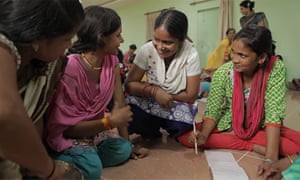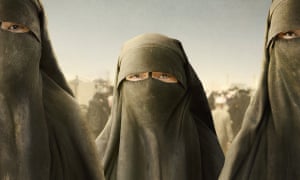‘Stop patronising me and give me an interview’: the female journalists speaking up for India’s poor
India’s only all-women news organisation is the subject of an award-winning documentary. The film-makers explain their inspiring courage and energy

A woman explains how a group of four men repeatedly broke into her house and raped her; six times so far. Did she go to the police? Yes, but officers refused to investigate. Instead, they threatened her and her husband. “These men can do anything. They can even kill us,” the victim says to the reporter, Meera, who is filming on her smartphone. As Meera leaves, the woman’s husband tells her that she is their only hope. “We don’t trust anyone except Khabar Lahariya.”
Khabar Lahariya is India’s only all-female news organisation. Based in Uttar Pradesh, its journalists passionately believe in reporting rural issues through a feminist lens.
After interviewing the rape victim, Meera walks to the police station where the officer in charge squirms, feebly making excuses for inaction on the case. Meera is filming him, so he can’t send her packing – like his officers did the victim. This is grassroots journalism at its finest: uncovering stories of discrimination and exposing abuses of power.
What makes Khabar Lahariya’s success even more stunning is that most of its journalists – like many of the ordinary people whose stories they report – are Dalits, the lowest status in India’s caste hierarchy. Their situation is especially dire in rural areas such as this corner of Uttar Pradesh, where the organisation opened in 2002. It began as a temporary project funded by an NGO to train women in a village to write a newsletter. The idea was that their voices were missing from mainstream media; what might their stories look like if someone bothered to pay attention? When funding ended, the organisation lived on.
Now, Khabar Lahariya is the subject of a documentary, Writing With Fire, filmed over five years by the wife and husband team Rintu Thomas and Sushmit Ghosh. Their film features upsetting interviews with victims of violence, but it’s an inspiring portrait of a team of exceptionally talented and committed women. The film-makers pitched up at the organisation in 2016 as Meera and her colleagues began transitioning from print to digital. The process was particularly difficult in a newsroom where some staff members were semi-literate, and others had never used a smartphone.
The film-makers were shocked by the caste discrimination they saw, says Ghosh. “We have been making films across India for 12 years together, but this was an eye-opener. You go into the interior heartlands, and you realise how structured and organised the practice is.” What interested them was seeing how the reporters, who are doubly discriminated against – first as Dalits, then as women – took on systems of oppression. “Men in positions of power are used to seeing Dalit women cleaning their toilets. They’re not used to seeing them with mobile phones, challenging them about accountability and governance. It stumps them,” he says with a grin. The group’s most popular YouTube posts have 8m hits.
Thomas adds that many of the journalists have changed their surnames, which can be a giveaway as to religion and caste. They are now known as “Devi”, the Hindi for “goddess”. “It’s a generic word that women choose when they discard their caste identity. This is a caste-neutral term. That in itself is a very strong political statement to make.”
The film focuses on three women working at the organisation. Meera is the chief reporter. After marriage at 14, she insisted on finishing her education, and gave birth to her first child while still at school; her mother-in-law used to shout up to the classroom when the baby needed feeding. Meera is a polite but dogged interviewer of men in power, and is compassionate towards victims. She is also a gifted leader who recognises that what often holds back the women in her newsroom is a lack of confidence. That’s the case with one rookie reporter, Shyamkali, a domestic violence survivor. “She would be nowhere in life were it not for Khabar Lahariya; no one would believe in her because she didn’t believe in herself,” says Thomas.
One woman not lacking in confidence is Suneeta an ambitious young journalist , who worked in an illegal mine as a child. These days, her coverage of the organised crime gangs that run the mines is regularly picked up by national media outlets. Suneeta is funny and fearless. “Stop patronising me and give me an interview,” she snaps at a man who mocks her for arriving on foot, rather than by car, at an accident where miners have been buried alive.
“Suneeta is amazing, sticking it up the system, and she’s so courageous,” says Ghosh. In one scene, the film demonstrates the difference between the Khabar Lahariya approach and that of their male counterparts in the mainstream media. Suneeta arrives at a murder scene where a woman has been killed with an axe, allegedly by a group of men. She crouches down on the ground, at eye level with the victim’s husband, and gently interviews him. A couple of male journalists buzz around, debating whether to recycle a script from a murder package they did the previous day to get the story out quickly.
India is one of the most dangerous places on earth to be a woman; a rape is reported every 15 minutes. “Somehow when Khabar Lahariya reports these stories there’s a lot of sensitivity,” says Thomas. “A lot of times a rape is reported on as an isolated crime, but the Khabar Lahariya line of inquiry is that there is gender-based violence and a lot of times caste is included. Most importantly, they want to foreground the woman.”
Many victims of rape do not go to the police. Perpetrators threaten families, and even kill their victims. In the areas where Meera, Suneeta and their colleagues operate, that is changing, says Thomas. “With the coming of Khabar Lahariya, women have found confidence in sharing their stories. These journalists are making sure that cases are reported. They hold people accountable. There is an understanding that it’s not going to just go unnoticed.”
Khabar Lahariya sees its role as more than merely writing stories – it has a moral responsibility to give a voice to the voiceless. So, the editorial policy requires journalists to follow up every article after four weeks. If no action has been taken by those in authority, they write a follow-up story, tagging district officials on social media, creating noise. It’s a style of forcing accountability that gets results. In the film there’s a punch-the-air montage of the paper’s greatest hits: electricity coming to a remote village; schools built; roads surfaced. Its reporting has also led to men being arrested and jailed for rape.
Airing uncomfortable subjects is one of Khabar Lahariya’s biggest achievements, Thomas believes. “In Indian society, you don’t talk about things that bring shame to the family, shame for yourself. So the consensus is: let’s hush it up. We need to reconsider whose shame [it is]. And that’s what the feminist lens is; you’re able to think differently from the way you’re trained to think by your family, your community, your society. That revolution of thought is penetrating very slowly in the areas Khabar Lahariya is working.” The women also report on menstruation and sex workers. “These are words no one wants to hear. Men are like: ‘Why are you talking about this?’ But having these conversations will take us forward as a society.”
It is exhausting work. A typical day for a journalist begins at 5am, travelling by train, bus or rickshaw – their budget doesn’t stretch to cars. The final leg of the journey is usually a two- or three-hour walk. In summer, temperatures in Uttar Pradesh can hit 40C (104F). It’s also dangerous, says Thomas. “They’re playing with fire every day. Asking those uncomfortable questions in that region is very risky.” Ghosh nods. “Just last month, a male journalist was killed because he was covering a story on the mining mafia in Uttar Pradesh. That’s how dangerous it is.” The women have received death threats, and had mobs turn up at their homes. The shift to online has led to relentless social media trolling.
Ghosh talks about the activism in the wider Dalit community. “Just as there is a Black Lives Matter movement, there is Dalit Lives Matter. You may be a young Dalit scholar sitting in southern India, but on Twitter you have a following of more than 50,000 people.” He mentions the recent Isabel Wilkerson book Caste: The Lies That Divide Us, which draws a comparison between racism in the US, the caste system in India, and Nazi Germany. “I see more and more conversations centred on the Dalit movement, and the importance of being aware of your own privilege as you move in these spaces.”
Thomas and Ghosh were gutted when the premiere of the film at Sundance was moved online because of Covid – it won the World Cinema audience prize for best documentary. They had been desperate to bring the film’s trio of reporters to the festival, says Ghosh. “They should be up on stage handling the audience’s questions. And we wanted them to see the audience telling them: your work is amazing.”
For the film-makers, the women of Khabar Lahariya represent 21st-century India. “They symbolise the quintessential modern Indian woman, not just a modern Indian Dalit woman. They are going into places that are unprecedented.”
Writing With Fire screens at the Sundance film festival in London on 1 August, with regional screenings from 30 July.



